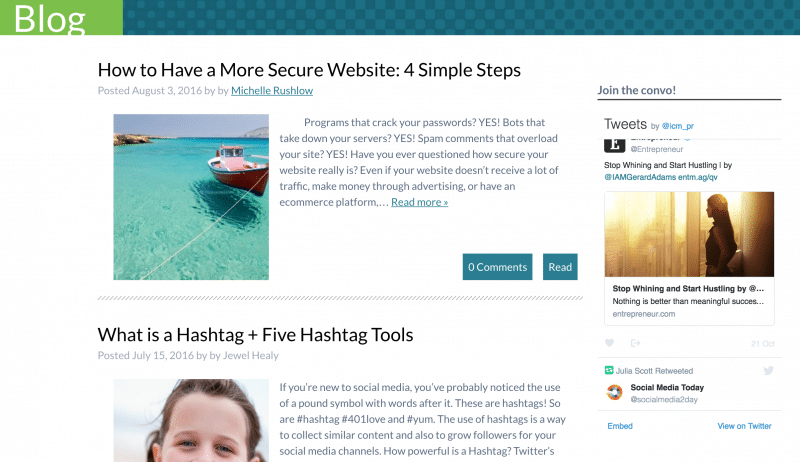If I can learn how to boost SEO, you can, too. My background is in journalism and online marketing, not coding. I have become an expert in SEO the old-fashioned way: painstaking research, relentless networking, and more than a decade of trial and error.
What is SEO? Search Engine Optimization is the craft of showing up high in search engine results. Ask yourself, when was the last time you clicked on the second or even third page of results, and you’ll grasp the importance of SEO. (Do you like learning through watching videos? Check out our 80-second video that explains SEO)
There are two main ways to play the SEO game: backend and frontend.
- Backend SEO is technical (optimizing meta data, title tags, and creating xml sitemaps, and lots more). We offer some backend SEO services, and have great connections with consultants who provide additional support in this area.
- Frontend SEO is not as technical (executing social media strategies, publishing blog posts, updating a website, and lots more), and is often low-hanging fruit. It does require time, but it is time well-spent with a high ROI. This is where my decade of experience comes in.
This post is for anyone who wants to learn how to boost SEO (on the frontend side) without hiring someone to do it for them (although that’s a really good way to get it done quickly).
Though frontend SEO is not highly technical, basic computer and Internet skills will come in handy. Let’s dive right in.

1. Optimize your images
Optimize every image on your website. This adds more keywords to your website, which helps search engines match your web pages with the searches potential customers are conducting on their laptops, tablets, and mobile devices. The more matches there are, the more likely your page is likely to show up high in the results.
What are keywords? Keywords are the most frequently used words and phrases that people use to find things on the Internet. An example of a popular keyword we discovered for one client is “newport harbor cruise.”
Rename any images you plan to use on your website or social media feeds using keywords separated by hyphens.
Here are some examples of bad image optimization, and the SEO improvement:
- sailboatpic1.jpg becomes –> newport-harbor-cruise.jpg
- fishandchipnewportri.jpg becomes –> fish-and-chips-jos-bistro-newport-ri.jpg
- photo123XYZ.jpg becomes–> graphic-design-services-cranston-ri.jpg
In the first example above, if a client above had multiple photos that were similar, she could distinguish them by adding identifiers to the base keyword formula (i.e. newport-harbor-cruise-sailboat-1.jpg).
2. Add your address
If you are a local business and/or location is important to your business, add your business address, including your city and state, to your homepage. It is also recommended to add your full address to every page of your website. This helps Google and other search engines connect your business with users who are trying to find you. Here’s one restaurant that does this well.
3. Share your digits
Make it easy for potential customers to call you. Add your phone number near your address on every page. How’s that for a quick way to boost SEO?

4. Claim + Optimize online listings
This may include relevant sites such as TripAdvisor, Yelp, G+/Google My Business, The Knot, YellowPages, OpenTable, and many more. Keep messaging as consistent as possible. Add top notch photography to your online listings – that means hiring a professional! Strong images directly help create the feeling your potential clients have when they form an opinion of your brand. I recommend Marianne Lee Photography out of Newport, RI.
GO TO How to Optimize Your TripAdvisor page in 6 Easy Steps.
5. Freshen monthly
Publish fresh content at least once a month on your website to boost SEO. Content is still king! One easy way to do this is through a blog. Blog posts should be a minimum of 600 words and ideally 1,000 words. Other options are to publish your own press releases. Search engines like to see that someone is taking care of a website. Well-cared for websites are more likely to be valuable to users, and therefore are more likely to show up high in results. See our related article on 10 tips for SEO blogging.
6. Get social
Update at least one social media platform at least once a week. Use photos with all updates (as much as humanly possible). Fill out all possible profile information for your chosen social media platform. Search engines like to see activity around your brand, and this includes social updates and engagement. While you’re at it, join us on Instagram.

7. Embed your feeds
Embed your top social media feed into your website. This helps your website look active and cared for in the eyes of Google and other search engines. Most social media platforms make this easy to do. Log into your top social media feed, and check your Settings tab for code to embed. Or call your favorite tech person! This makes your website seem more active and current. Below is an example of one way this can look on a website.

See how the Twitter feed is nestled onto the right side of the above screenshot of a webpage?
8. Solicit reviews
Positive online reviews are a huge driver of customers to your business and phone calls to your business. Ask politely for reviews but don’t be pushy because you want only the most satisfied customers to engage you on this request. If you are seeking reviews on TripAdvisor, for example, simply let people know your business is on TripAdvisor (which has a neat array of printed marketing materials via their online platform.) A few positive reviews every month or so will really boost SEO.

